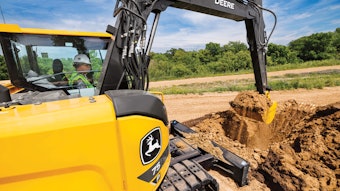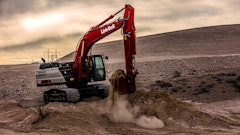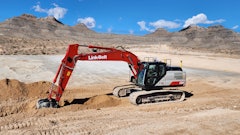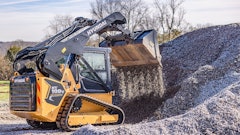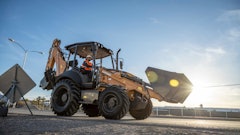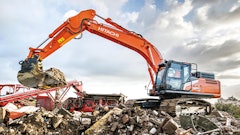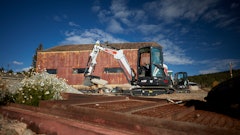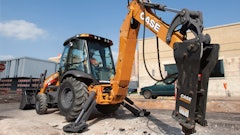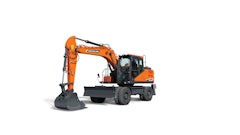
In the dynamic world of construction machinery, wheeled excavators stand out as powerful and versatile assets for construction professionals. These machines have transcended the conventional tracked excavator role, emerging as essential tools that redefine on-site efficiency. As construction sites evolve, particularly in urban areas, wheeled excavators are becoming integral, allowing work to be completed over larger areas. This article delves into the core features, advantages, and diverse applications of wheeled excavators, showcasing their pivotal role in shaping the contemporary construction landscape.
In recent years, compact wheeled excavators within the 6-ton to 13-ton range have emerged as a critical segment within the construction machinery market. This category, often referred to as the "sweet spot" for many construction applications, strikes a balance between power and maneuverability, making these machines indispensable for a wide range of projects.
While compact wheeled excavators excel in specific aspects of urban construction, it's essential to contrast their attributes with backhoe loaders—a commonly used alternative in the construction industry.
- Maneuverability and Space Efficiency: Compact wheeled excavators outshine backhoe loaders in maneuverability within confined spaces. The wheeled excavator's ability to navigate tight corners and work in restricted areas, such as a single lane of traffic, makes it a preferred choice for urban projects where space is limited, providing a distinct advantage over the more cumbersome maneuverability of backhoe loaders.
- Dedicated Excavation Focus: Unlike backhoe loaders, which combine a front loader and rear excavator, compact wheeled excavators are designed with a dedicated focus on excavation tasks. This specialization allows them to excel in precision digging, making them more suitable for tasks such as trenching, foundation excavation, and utility work in urban environments.
- Quick and Efficient Transportation: Compact wheeled excavators often have an edge in terms of transportation efficiency. Their wheeled design and hydrostatic drive allow for faster movement between jobsites (up to 40 km/h), especially when compared to backhoe loaders that might require additional transportation considerations, such as a truck and trailer. This advantage contributes to quicker response times and increases overall project efficiency.
While wheeled excavators have already proven their usefulness in urban construction projects, their adaptability extends far beyond city limits. In unique niches that demand precision, maneuverability, and versatility, wheeled excavators are quickly becoming indispensable assets.
- Golf Course Maintenance: The meticulous care required to maintain a golf course demands equipment that can delicately handle tasks without causing disruption to the landscape. A compact wheeled excavator, with a set of wide tires, can move seamlessly across greens and fairways, offer a precise solution for tasks such as bunker shaping, pond maintenance, and tree planting. The reduced ground disturbance while turning, of wheeled excavators (compared to a tracked machine) ensures minimal impact on turf surfaces, preserving the aesthetics of the golf course.
- Cemetery Landscaping and Maintenance: In serene cemetery landscapes, wheeled excavators play a crucial role in landscaping and maintenance. Their agility allows operators to navigate through rows of headstones and tight spaces with ease, facilitating tasks like grave excavation, monument installation, and general landscaping. The higher travel speed, when compared to a traditional excavator, allow it to quickly transition to different areas of larger cemeteries.
- Agricultural Operations: In the expansive world of agriculture, the high travel speed of compact wheeled excavators find utility in various tasks. Whether it's universal tasks like clearing land for new crops and digging irrigation ditches, or a specific niche like cleaning cranberry marshes, these machines adapt to the diverse needs of agriculture. The ability to attach specialized implements, such as augers, grapples, or mowers makes wheeled excavators an asset for farmers seeking efficient solutions for their operations.
- Versatility in Forestry and Logging: Wheeled excavators are not confined to manicured landscapes; they venture into rugged terrains, proving their mettle in forestry and logging operations. Their mobility allows access to remote locations, while attachments like grapples enable efficient handling of logs. The agility of wheeled excavators ensures that they can navigate through densely wooded areas, contributing to sustainable forestry practices.
Not just a change in form and function, compact wheeled excavators are also standing at the forefront of technological advancements in construction equipment.
- Telematics Systems for Real-Time Insights: Modern wheeled excavators are equipped with sophisticated telematics systems that revolutionize how construction professionals manage and monitor their fleets. These systems collect and transmit real-time data on machine health, fuel consumption, utilization, and location. Fleet managers can access this information remotely, enabling proactive maintenance planning, minimizing downtime, and optimizing overall operational efficiency.
- Precision through Machine Control: The integration of advanced machine control technology has transformed the way wheeled excavators operate on construction sites. GPS-guided systems enable precise digging and grading, ensuring that excavation tasks meet exact specifications. This technology not only enhances accuracy but also contributes to increased productivity by reducing the need for manual adjustments and rework. Machine control systems bring a new level of efficiency to tasks such as trenching, grading, and foundation excavation.
- Customizable Controls for Operator Comfort: Some wheeled excavators now offer customizable control systems that cater to the preferences and comfort of individual operators. Adjustable joysticks, touch-screen interfaces, and programmable buttons allow operators to tailor the machine's controls to their liking. This not only enhances operator comfort but also contributes to increased productivity as operators can work more efficiently with controls that suit their unique preferences.
- Tiltrotators: Enhancing Versatility and Precision: Tiltrotators have emerged as game-changers in the world of wheeled excavators. While they already have an established foothold in Europe, they are starting to gain popularity in North America. These hydraulic attachments allow the excavator's bucket or other attachments to rotate, tilt, and pivot, increasing flexibility. Tiltrotators enable operators to access challenging angles, work around obstacles, and execute tasks with a level of precision that was previously hard to achieve. From landscaping to utility work, tiltrotators unlock new possibilities for wheeled excavators.
As we peer into the future of technology and envision the modern jobsite, the need for a common digital language that is manufacturer—and machine-independent is becoming increasingly crucial. This common digital language will enhance communication among site developers, fleet managers, operators, and even the machines and attachments themselves.
Addressing this complex task of developing a common digital language is an organization known as Machines in Construction 4.0 (MiC 4.0, link). MiC 4.0 comprises over 100 members from various equipment manufacturers and stakeholders across seven countries.
An excellent case study demonstrating early adoption of MiC 4.0 standards is an all-new wheeled excavator. Engineers collaborated closely with several tiltrotator manufacturers throughout the machine and software development process to ensure compatibility right from the factory. This translates to a "plug and play" experience when installing a tiltrotator on the wheeled excavator, with no need for additional software, controllers, or third-party joysticks. Moreover, it empowers the operator to choose their preferred brand of tiltrotator, and the machine seamlessly adapts the controls based on that specific make and model.
Compact wheeled excavators represent the future of construction, showcasing how technology enhances efficiency on the jobsite. With their advanced features and versatility across many applications, these machines provide a practical glimpse into the evolving landscape of construction machinery. In an era emphasizing connectivity, these excavators embody innovation, promising heightened productivity and efficiency in modern construction.
